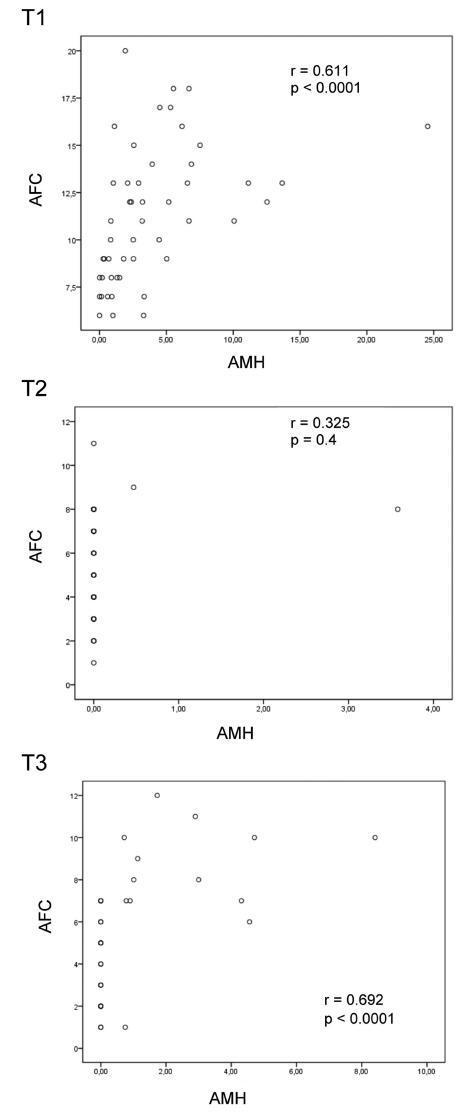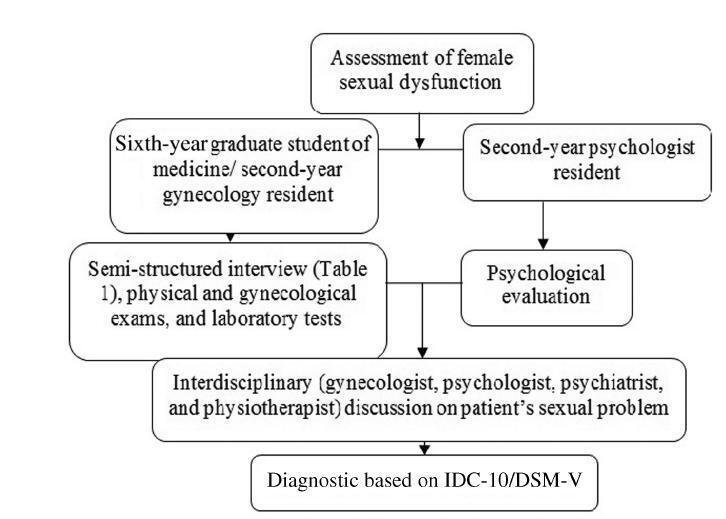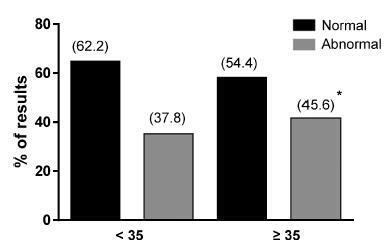-
Original Article
Antral Follicles Count and Anti-Müllerian Hormone Levels after Gonadotoxic Chemotherapy in Patients with Breast Cancer: Cohort Study
Revista Brasileira de Ginecologia e Obstetrícia. 2017;39(4):162-168
04-01-2017
Summary
Original ArticleAntral Follicles Count and Anti-Müllerian Hormone Levels after Gonadotoxic Chemotherapy in Patients with Breast Cancer: Cohort Study
Revista Brasileira de Ginecologia e Obstetrícia. 2017;39(4):162-168
04-01-2017Views108Abstract
Aim
To assess ovarian reserve (OVR) by means of follicle-stimulating hormone (FSH), anti-Müllerian hormone (AMH), and antral follicle count (AFC) measurement in eumenorrheic women with breast cancer, exposed to gonadotoxic chemotherapy.
Method
Fifty-two women (35.3 ± 3.8 years old) with breast cancer and undergoing cyclophosphamide-containing chemotherapy were enrolled. The assessment was performed before chemotherapy (T1) and after 2 (T2) and 6 months (T3).
Results
Six months after chemotherapy, the prevalence of regular cycles was 60%. Anti-Müllerian hormone decreased down to undetectable levels at T2 and T3 (T1: 2.53 [1.00–5.31]; T2 < 0.08; T3: < 0.08 [< 0.08–1.07] ng/mL), (p< 0.0001). Antral follicle count was 11 [8.0–13.5] follicles at T1 and lower at T2 (5.50 [3.75–8.0] and T3 (5.0 [2.5–7.0]) (p< 0.0001). In patients who remained with regular cycles during chemotherapy or resumed normal menses, FSH and estradiol levels remained unchanged.
Conclusion
Anti-Müllerian hormone and AFC are useful as markers of OVR decline in women exposed to chemotherapy. Follicle-stimulating hormone is only adequate in women who become amenorrheic.
Key-words AnovulationAnti-müllerian hormoneantral follicle countchemotherapy-induced amenorrheaOvarian reserveSee more
-
Original Article
Can the Pessary Use Modify the Vaginal Microbiological Flora? A Cross-sectional Study
Revista Brasileira de Ginecologia e Obstetrícia. 2017;39(4):169-174
04-01-2017
Summary
Original ArticleCan the Pessary Use Modify the Vaginal Microbiological Flora? A Cross-sectional Study
Revista Brasileira de Ginecologia e Obstetrícia. 2017;39(4):169-174
04-01-2017Views229See moreAbstract
Introduction
Vaginal pessary is used as a conservative treatment for pelvic organ prolapse (POP). Some studies have shown that common complaints of its use may include vaginal discomfort and increased vaginal discharge. Scant information is available about the microflora status after using this device.
Objective
To determine if the usage of vaginal pessary can interfere with the vaginal environment.
Methods
A cross-sectional study was performed from March of 2014 to July of 2015 including 90 women with POP. The study group was composed of 45 women users of vaginal pessary and 45 nom-users. All enrolled women answered a standardized questionnaire and were subjected to a gynecological exam to collect vaginal samples for microbiological evaluation under optic microscopy. Clinical and microbiological data were compared between study and control groups.
Results
Vaginal discharge was confirmed in 84% of the study group versus 62.2% in the control group (p< 0.01); itching was reported in 20 and 2.2%, respectively (p< .05); genital ulcers were only found in the pessary group (20%). There was no difference with regard to the type of vaginal flora. Bacterial vaginosis was prevalent in the study group (31.1% study group versus 22.2% control group), (p=.34).
Conclusion
Women using vaginal pessaries for POP treatment presented more vaginal discharge, itching and genital ulcers than non-users.
-
Original Article
Influence of Body Image in Women Undergoing Treatment for Breast Cancer
Revista Brasileira de Ginecologia e Obstetrícia. 2017;39(4):175-183
04-01-2017
Summary
Original ArticleInfluence of Body Image in Women Undergoing Treatment for Breast Cancer
Revista Brasileira de Ginecologia e Obstetrícia. 2017;39(4):175-183
04-01-2017Views234See moreAbstract
Objective
The objective of this study was to investigate the self-esteem of women with and without breast cancer regarding their body image.
Methods
A quantitative, case-control study in which 90 women with breast cancer were evaluated in the case group, and 77 women without breast cancer in the control group. For data collection, the body satisfaction scale (BSS), a scale adapted and validated in Brazil, and the Rosenberg self-esteem questionnaire were used. For the statistical analysis of the data, the Statistical Package for the Social Sciences software (IBM-SPSS, Chicago, Il, US), version 16.0 was used.
Results
Compared with the women without breast cancer, those with breast cancer were more dissatisfied with body image related to appearance. Women undergoing neoadjuvant chemotherapy were more dissatisfied with their appearance compared with those with cancer who were not undergoing this treatment. Mastectomy also accounted for more dissatisfaction concerning appearance among women who underwent the procedure compared with the women who were submitted to breast-conserving therapy.
Conclusion
Women with breast cancer were more dissatisfied with their body image compared with those without breast cancer, particularly following mastectomy or during chemotherapy. The self-esteem was found to be negatively affected in patients who were dissatisfied with their body image.
-
Original Article
A Model for the Management of Female Sexual Dysfunctions
Revista Brasileira de Ginecologia e Obstetrícia. 2017;39(4):184-194
04-01-2017
Summary
Original ArticleA Model for the Management of Female Sexual Dysfunctions
Revista Brasileira de Ginecologia e Obstetrícia. 2017;39(4):184-194
04-01-2017Views169See moreAbstract
Introduction
Sexual pleasure is fundamental for the maintenance of health and well-being, but it may be adversely affected by medical and psychosocial conditions. Many patients only feel that their health is fully restored after they resume normal sexual activities. Any discussion of sexuality in a doctor's office is typically limited, mainly because of a lack of models or protocols available to guide the discussion of the topic.
Objectives
To present a model designed to guide gynecologists in the management of female sexual complaints.
Methods
This study presents a protocol used to assess women's sexual problems. A semi-structured interview is used to assess sexual function, and the teaching, orienting and permitting (TOP) intervention model that was designed to guide gynecologists in the management of sexual complaints.
Results
The use of protocols may facilitate the discussion of sexual issues in gynecological settings, and has the potential to provide an effective approach to the complex aspects of sexual dysfunction in women. The TOP model has three phases: teaching the sexual response, in which the gynecologist explains the physiology of the female sexual response, and focuses on the three main phases thereof (desire, excitement and orgasm); orienting a woman toward sexual health, in which sexual education is used to provide information on the concept and healthy experience of sexuality; and permitting and stimulating sexual pleasure, which is based on the assumption that sexual pleasure is an individual right and is important for the physical and emotional well-being.
Conclusion
The use of protocols may provide an effective approach to deal with female sexual dysfunction in gynecological offices.

-
Original Article
Does the Access to Sun Exposure Ensure Adequate Levels of 25-Hydroxyvitamin D?
Revista Brasileira de Ginecologia e Obstetrícia. 2017;39(3):102-109
03-01-2017
Summary
Original ArticleDoes the Access to Sun Exposure Ensure Adequate Levels of 25-Hydroxyvitamin D?
Revista Brasileira de Ginecologia e Obstetrícia. 2017;39(3):102-109
03-01-2017Views90See moreAbstract
Objectives
To assess the prevalence of hypovitaminosis D, altered arterial blood pressure, and serum levels of glucose and lipids in community-dwelling women in the city of Ribeirão Preto, in the southeast of Brazil.
Methods
Thiswas a cross-sectional studyof women aged40-70years old.Calciumintake and level of sun exposure were assessed by means of a questionnaire. A blood sample was used to determine glucose, lipid profile and 25-hydroxyvitaminD(25[OH]D) concentration.
Results
Ninety-one women were enrolled (age = 54.2 ± 7.1 years). Themean serum 25(OH)D concentration was 25.7 ± 8.9 ng/mL. A total of 24 (26.4%) women had 25 (OH)D levels < 20 ng/mL. Seventy women (76.9%) had 25(OH)D levels < 30 ng/mL. Seventy-five women (90.4%) had inadequate calcium intake, and 61 women (67%) had appropriate sun exposure, 49 of whom (80.3%) had serum 25(OH)D levels < 30 ng/mL.
Conclusion
This study indicates that even in community-dwelling women, living in a city with high sun exposure, serum levels of 25(OH)D > 30 ng/ml are hardly reached. Thus, it is probable that other intrinsic factors besides sun exposure may regulate the levels of vitamin D.

-
Original Article
Frequency of Chromosomal Abnormalities in Products of Conception
Revista Brasileira de Ginecologia e Obstetrícia. 2017;39(3):110-114
03-01-2017
Summary
Original ArticleFrequency of Chromosomal Abnormalities in Products of Conception
Revista Brasileira de Ginecologia e Obstetrícia. 2017;39(3):110-114
03-01-2017Views102See moreAbstract
Purpose
To describe the frequencies of chromosomal abnormalities found in abortion material, and to observe its correlation to maternal age.
Methods
A retrospective study was conducted based on data obtained from the databank of a medical genetics laboratory in Belo Horizonte, MG, Brazil. A total of 884 results from products of conception analysis were included, 204 of which were analyzed by cytogenetics, and 680bymolecular biology basedon quantitative fluorescence polymerase chain reaction (QF-PCR). The frequency of individual chromosomal aberrations and the relationship between the presence of anomalies and maternal age were also evaluated.
Results
The conventional cytogenetics technique was able to detect 52% of normal and 48% of abnormal results in the analyzed material. Quantitative fluorescence polymerase chain reaction revealed 60% of normal and 40% of abnormal results from the samples evaluated by this method. The presence of trisomy 15 was detected only by cytogenetics, as it was not included in the QF-PCR routine investigation in the laboratory. A significant increase in abnormal results was observed among women aged 35 years or older compared with younger women (p = 0.02).
Conclusion
Chromosomal aberrations are still a major cause of spontaneous abortion, and the conventional cytogenetics technique is efficient for miscarriage material analysis, but molecular methods such as QF-PCR are adequate complementary strategies to detect the major chromosomal anomalies, leading to technical reports with reliable results.

-
Original Article
Upper Limb Functionality and Quality of Life in Women with Five-Year Survival after Breast Cancer Surgery
Revista Brasileira de Ginecologia e Obstetrícia. 2017;39(3):115-122
03-01-2017
Summary
Original ArticleUpper Limb Functionality and Quality of Life in Women with Five-Year Survival after Breast Cancer Surgery
Revista Brasileira de Ginecologia e Obstetrícia. 2017;39(3):115-122
03-01-2017Views180See moreAbstract
Objective
To evaluate the correlation between upper limb functionality and quality of life in women with five-year survival following breast cancer surgical treatment. The secondary objective was to evaluate the function of the ipsilateral upper limb and the quality of life in relation to the type of surgery and the presence of pain.
Methods
The Disabilities of Arm, Shoulder and Hand (DASH), and the Functional Assessment of Cancer Therapy - Breast plus Arm Morbidity (FACTB + 4) questionnaires were used to evaluate upper limb function and quality of life respectively. Data distribution was verified by the Shapiro-Wilk test. Pearson's correlation coefficient was used for the parametric variables, and Spearman's rank correlation coefficient was used for the distribution of non-parametric variables. The statistical significance was set at 5% (p < 0.05).
Results
The study included 30 patients, with a mean age of 51.23 (±8.72) years. The most common complications were: pain (50%), adherence (33.3%), and nerve lesion (20.0%). There was a moderate negative correlation between the instruments DASH and FACTB + 4 (total score), r = -0.634, and a strong negative correlation between the DASH and the FACTB + 4 armsubscale, r = -0.829. The scores of both questionnaires showed significant difference on the manifestation of pain. However, there was no significant difference found when comparing the scores considering the type of surgery performed.
Conclusions
Five years after surgery, the patients showed regular functionality levels on the ipsilateral upper limb and decreased quality of life, especially in the group manifesting pain.

-
Original Article
Underdiagnosis of cervical intraepithelial neoplasia (CIN) 2 orWorse Lesion inWomenwith a Previous Colposcopy-Guided Biopsy Showing CIN 1
Revista Brasileira de Ginecologia e Obstetrícia. 2017;39(3):123-127
03-01-2017
Summary
Original ArticleUnderdiagnosis of cervical intraepithelial neoplasia (CIN) 2 orWorse Lesion inWomenwith a Previous Colposcopy-Guided Biopsy Showing CIN 1
Revista Brasileira de Ginecologia e Obstetrícia. 2017;39(3):123-127
03-01-2017Views174Abstract
Objective
Expectant follow-up for biopsy-proven cervical intraepithelial neoplasia (CIN) 1 is the current recommendation for the management of this lesion. Nevertheless, the performance of the biopsy guided by colposcopy might not be optimal. Therefore, this study aimed to calculate the rate of underdiagnoses of more severe lesions in women with CIN 1 diagnosis and to evaluate whether age, lesion extent and biopsy site are factors associated with diagnostic failure.
Methods
Eighty women with a diagnosis of CIN 1 obtained by colposcopy-guided biopsy were selected for this study. These women were herein submitted to large loop excision of the transformation zone (LLETZ). The prevalence of lesions more severe than CIN 1 was calculated, and the histological diagnoses of the LLETZ specimens were grouped into two categories: "CIN 1 or less" and "CIN 2 or worse."
Results
The prevalence of lesions diagnosed as CIN 2 or worse in the LLETZ specimens was of 19% (15/80). Three women revealed CIN 3, and 1 woman revealed a sclerosing adenocarcinoma stage I-a, a rare type of malignant neoplasia of low proliferation, which was not detected by either colposcopy or previous biopsy. The underdiagnosis of CIN 2 was not associated with the women's age, lesion extension and biopsy site.
Conclusions
The standard methods used for the diagnosis of CIN 1 may underestimate the severity of the true lesion and, therefore, women undergoing expectant management must have an adequate follow-up.
Key-words BiopsyCervical intraepithelial neoplasiacolposcopic surgical proceduresColposcopyNeoplasmsuterine cervicalSee more


